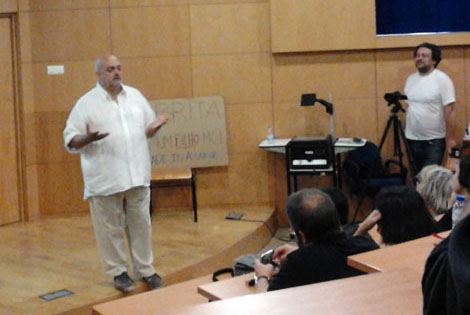 «The artist's activity does not have to be in accord with what society expects», said Pedro Cabrita Reis, at a conference at the University of Algarve, in Faro, concerning the question posed by a student about his artistic intervention in the Bemposta Dam, in Douro.
«The artist's activity does not have to be in accord with what society expects», said Pedro Cabrita Reis, at a conference at the University of Algarve, in Faro, concerning the question posed by a student about his artistic intervention in the Bemposta Dam, in Douro.
"The ethics of an artist is not about what society's immediate response would be," he added. Goat Kings, to comment on the adverse reaction that his intervention in the dam, which the artist painted in bright yellow, caused among the population, a reaction that some media, especially television, exploited to the point of exhaustion.
Cabrita Reis underlined that the intervention in the Bemposta Dam was ordered by EDP, and found it "perfectly expectable and healthy" that there had been a "perplexity and refusal on the part of the population". "We would hardly be if everyone went there to clap their hands," he stressed.
Faced with an intervention like the one carried out at the dam, painting the gray concrete wall in bright yellow, Cabrita Reis admits that, «in the initial moment, there are always fractures, people have difficulty in spontaneously incorporating transformations in their landscape. and have every right to react adversely”.
And EDP, owner of the dam project and which placed the order, should have made some effort to explain to the population what was going to happen, one might ask. “EDP should have told people, should have gone to local authorities to explain what was going to be done there. I was available for that!».
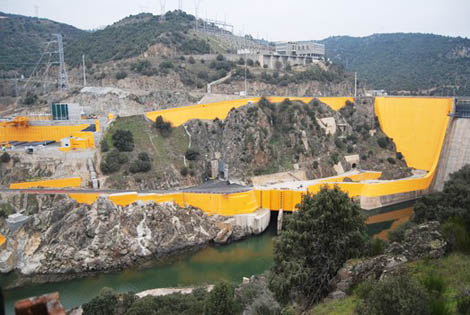
The artist also criticized the «demagogic way in which the media managed the issue». "The approach that televisions took to people was demagogic, urban, paternalistic," he said vehemently. «It was a reactionary use of the media in relation to the work of a contemporary artist».
All the more because, recalled Cabrita Reis, “strangely, [the media] never remembered to come and confront the artist. That is the project of an artist who should have been called to stone, to talk about him». And that, he stressed, was never done.
Despite the normal negative reaction of people to his intervention in the Bemposta Dam, the truth is that the artist believes that a large part of the controversy was created and artificially exploited by the media. In such a way that «there are already people photographing themselves up front for weddings», concluded Cabrita Reis.
Pedro Cabrita Reis was speaking at the last of seven conferences included in the Visual Arts Cycle, organized by Center for Research in Arts and Communication (CIAC), which took artists, curators and gallery owners to the University of Algarve to talk about their work, the market and the situation of the arts in Portugal.
The amphitheater located on Campus da Penha was full of people interested in listening and debating with one of the greatest contemporary European plastic artists.
In addition to students from UAlg's Visual Arts Degree or from their Master's Degree in Communication, Culture and Arts, other renowned artists also took part in the debate, such as Xana (Alexandre Alves Barata), Rui Sanches ou Pedro Cabral Santo, all professors at that university in the Algarve.
«Pedro Cabrita Reis is not just any person»
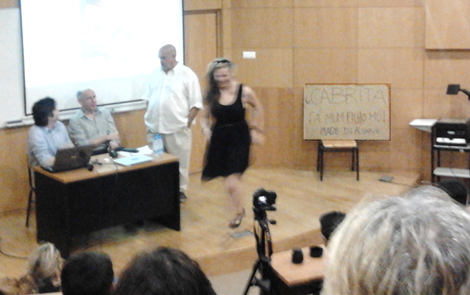
The conference, which started slightly late, was already after 17:30 pm, because Pedro Cabrita Reis (PCR) arrived directly from one of his legendary long lunches, it began with an adventure that made people laugh with laughter and a good-humored response from the artist. One student – Kate – decided to mark the art form the arrival of Cabrita Reis, sporting a cardboard poster, like those that the most fanatical football fans show to their idols, with the following words: «Cabrita, Fá Mum Filho Mó! Made in Algarve». To which the artist replied "Let's go!"
Once inside the amphitheater, Cabrita Reis asked the young artist to place her poster visible on the small stage where she spoke. And later, almost at the end of the conference, which would last three hours, when the young woman was getting ready to leave, the artist called her and, with his fist, wrote on the poster: "only one?".
However, the conference had already started, with an intervention by Pedro Cabral Santo on the work of his guest, when a young man entered the room with a plastic supermarket bag in his hand and went to Cabrita Reis to give it to him.
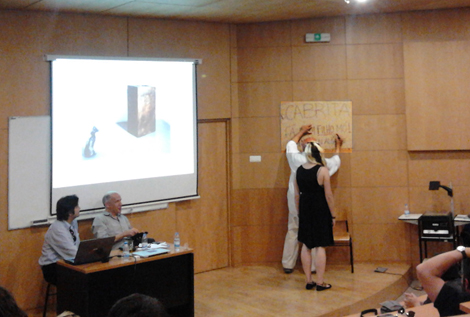 Inside, the artist took out a glass of ice and a bottle of Johnny Walker Black Label whiskey, still inside the paper box. He poured some into the glass and sipped it, alternating with water, throughout the conversation. Later, glass in hand, he would comment: "this is a tribute to Vinicius de Morais".
Inside, the artist took out a glass of ice and a bottle of Johnny Walker Black Label whiskey, still inside the paper box. He poured some into the glass and sipped it, alternating with water, throughout the conversation. Later, glass in hand, he would comment: "this is a tribute to Vinicius de Morais".
Pedro Cabral Santo began by underlining that «Pedro Cabrita Reis is not just any person – «no one is just any person», commented PCR in an aside – he had a very big impact on other people, it was very important for my generation». “Behind us there was someone who opened the way”, added Pedro Cabral Santo, to emphasize: “here we have a live character from the History of Art”.
Cabral Santo would summarize the work of the guest of the afternoon saying that he is an “artist-builder”. «Pedro is a painter by birth, from time to time he revisits painting, without any fear, he goes there and doesn't hide it. But he is an artist-builder».
PCR would add: “there are those who want to link my work to architecture. Nothing more wrong! My territory is before the territory of architecture, it is that of construction, of a more philosophical and anthropological nature. Architecture proposes to manage the social space, it proposes to nullify and soften, it is sociological in nature. My work is an anthropological exercise in the construction of a living space».
And what exactly is PCR? “I'm a painter who does other things – I have lots of paintings made with cement blocks, with fluorescent lights, with pieces of wood, but I even have some made in oil”, he joked.
Turning to the Arts students, Cabrita Reis said: “you should never limit what you want to do, you should never restrict it. There are no painters, sculptors, filmmakers. There are people who live creativity».
Pedro Cabrita Reis, graduated from the Lisbon School of Fine Arts, and who began his professional life as a high school teacher – and who taught in Portimão, for example – took advantage of the fact that he was in front of an audience trained in his students and teachers to express their ideas about what the school should be.
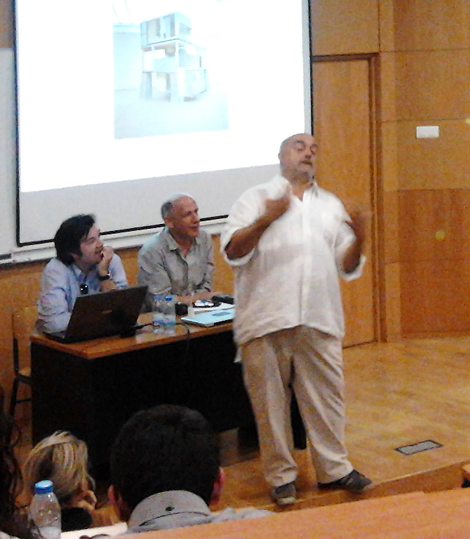 “School is no guarantee of what they want to do in life. It is a wonderful moment for people to meet, a community that they must use and manage. But if you don't have anything stronger in yourselves, any type of conviction that makes you go further will not be the passage through this institution that will do it».
“School is no guarantee of what they want to do in life. It is a wonderful moment for people to meet, a community that they must use and manage. But if you don't have anything stronger in yourselves, any type of conviction that makes you go further will not be the passage through this institution that will do it».
“You cannot think that the school will save you, but neither can you refuse it. Between one thing and another, they have to build some territory».
The artist also criticized what he called the «Stigma of Bologna»: «concentrating [the courses] in a short period of time, to make more money turn in a university structure», through the subsequent offer of master's and doctoral degrees. "Europeans, unfortunately, are trying to rebuild the American model."
Xana, a professor at UAlg and also an artist, would comment: «before there was the paradigm that it was in the troops that boys became little men, now that paradigm is the university».
Mirian Tavares, coordinator of CIAC, underlined, in turn, that she often tells students that “the university is not an ATL, it is experimentation, it is doing a lot of things that they cannot do abroad”. "You have to run after it!", urged the teacher. "If you need to burn down the rectory, burn the rectory," he concluded, eliciting laughter and many comments from the audience.
Perhaps taking this motto, and after a lively conversation with one of the students, at the end of the conference, Pedro Cabrita Reis asked for a lighter and offered it to the young man: «I'll give you this symbolic lighter. It is this lighter and your individual will that will change things. Never apologize or wait for anything!».
«Artist is not an adjective»
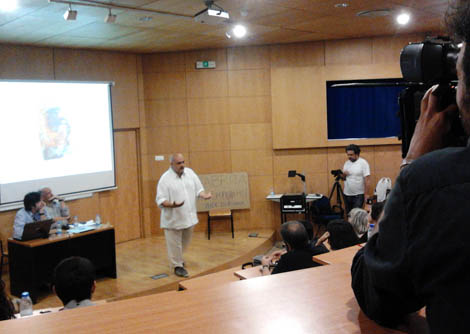 There was also someone from the audience who wanted to know about Pedro Cabrita Reis' creative process. "I'm the worst customer of plastic arts stores, I work with garbage," replied the artist.
There was also someone from the audience who wanted to know about Pedro Cabrita Reis' creative process. "I'm the worst customer of plastic arts stores, I work with garbage," replied the artist.
“It's not that all my works are made with things I retrieve from the trash, there are things I have them made, or sometimes I buy the best paper there is. But that's a tiny fraction of my work,” he explained.
In Rome, for example, the 16 pieces for an exhibition were built with materials found in the courtyard “of the gallery, which was the dump for the neighbors' garbage. Heaters, old doors, lead pipes… there was an absolutely irresistible wealth of garbage that came to meet my work”. And that ended up being integrated in the pieces of the exhibition.
«Imagine that I am from a savage tribe that collects the objects of interest in the territory», guarding some, rejecting others.
“But isn't that exactly the same if you use oil on canvas?”, asked Rui Sanches. «When a person draws a picture they also decide: I'm going to erase this or leave that weird line because I'm interested in weirdness».
In fact, replied PCR, «artistic creation is the moment of looking, the moment of choice. The artist defines himself by the choices he makes, whether on the drawing he makes or the rubbish in the courtyard of Rome. I prefer to work with garbage, others prefer to work with oil. But there is no fracture of thought here».
«Artist is not an adjective that is put on top of a person. An artist is a person who has a particular way of being in life. It is this difference that makes us always at the service. The artist carries within himself something that he cannot get rid of: he looks at what everyone looks at in a different way. And it is in this “only” that the question is».
"And the difference is where it is?" asked Xana.
"Is at work. Each one, in their work, materializes this difference».
And in the work of Pedro Cabrita Reis, the most recognized contemporary Portuguese artist, who even has three of his pieces on permanent exhibition in a room on the 5th floor of the Tate Modern from London, this difference is palpable.


















Comments